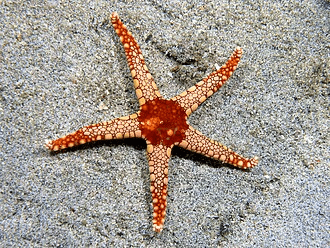A squirrel and a maple tree are examples of which of the following?
a. genes
b. cells
c. organisms
d. populations
c. organisms
Which of the following is NOT generally used when identifying and classifying organisms?
a. common name
b. genus and species
c. binomial nomenclature
d. scientific name
a. common name
What feature of eukaryotic cells makes them different from prokaryotic cells?
Their organelles are bound by membranes.
Name ONE characteristics that all autotrophic plants share.
Plants are eukaryotic, have cell walls that contain the carbohydrate cellulose, and carry out photosynthesis, using the pigment chlorophyll to transform sunlight into chemical energy.
How many colours are in the rainbow?
7
What is the basic unit of structure and function in living things?
A cell
Which of the following is the proper scientific name of the guinea pig?
a. Cavia porcellus
b. Porcellus Cavia
c. Cavia porcellus
d. porcellus cavia
c. Cavia porcellus
Which group of organisms is sometimes called a "stuff drawer" for items that don't seem to belong anywhere else?
the kingdom Protista
Which term describes the body symmetry of this cnidarian?
Radial Symmetry
What is the name of the tallest grass on earth?
A) Wheat
B) Bamboo
C) Sugarcane
D) Corn
B) Bamboo
What is the term for a type of organism with group members that can breed freely and produce fertile offspring?
Species
Which term describes the process of identifying, naming, and organizing similar species into larger groups?
Taxonomy
Which of the following describes a type of bacteria that obtains its carbon from carbon dioxide rather than organic molecules?
a. photoautotrophs
b. chemoheterotrophs
c. heterotrophs
d. photoheterotrophs
a. photoautotrophs
Which term refers to the upper surface of an animal with bilateral symmetry?
Dorsal
On what continent will you not find bees?
Antarctica
What is the term that describes the variety of life on Earth?
biodiversity
What are the three domains used by biologists?
The three domains are Archaea, Bacteria, and Eukarya.
Which of the following structures found in hyphae make most fungi multicellular?
a. mitochondria
b. cross-walls
c. cytoplasm
d. mycelium
b. cross-walls
What allowed vascular plants to successfully adapt to living on land?
a. They photosynthesize more efficiently than non-vascular plants.
b. They have colourful flowers to attract insects.
c. They have efficient fluid-conducting tissues.
c. They have efficient fluid-conducting tissues.
What does DNA stand for?
Deoxyribonucleic acid
List the three levels of biodiversity, from broadest to most specific.
ecosystem diversity,
species diversity,
and genetic diversity
How do the organisms of domain Eukarya differ from the organisms of domains Bacteria and Archaea?
Eukaryotic cells have nuclei (and other organelles)
What is the key difference between fungi and plants?
Plants are photosynthetic, while fungi are heterotrophic.
Name the 5 types of plants (that we looked for on our greenhouse field trip)
- moss
- ferns
- algae
- gymnosperms
- angiosperms
What is the only planet that spins clockwise?
Venus